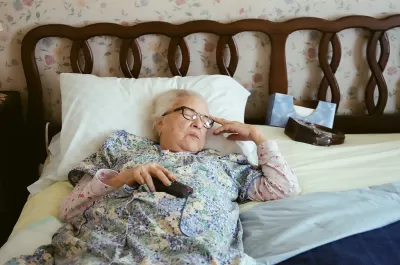No, this isn't a story about alien invaders, but rather an innovative form of housing that may revolutionize how aging Americans spend their final years.

At 88, Viola Baez is an unlikely pioneer. But as the first first private inhabitant of a MedCottage, she's the reluctant resident of a shed-size dwelling that may offer an attractive balance between independence and special care for some of the 72 million Americans who will be 65 or older in less than twenty years, reports Fredrick Kunkle.
"The MedCottage, designed by a Blacksburg company with help from Virginia Tech, is essentially a portable hospital room. Virginia state law, which recognized the dwellings a few years ago, classifies them as 'temporary family health-care structures.' But many simply know them as 'granny pods,' and they have arrived on the market as the nation prepares for a wave of graying baby boomers to retire."
Viola's "pod" is 12x24 feet, blending bedroom, kitchenette, foyer and bath "the way that a fork and spoon combine to form a spork."
"The idea for the MedCottage came from the Rev. Kenneth J. Dupin, a minister in southwest Virginia who wondered why Americans didn’t take better care of their elders," says Kunkle. "He created N2Care, a company that designed the MedCottage with help from the Virginia Tech Corporate Research Center. They stuffed its steel shell with the latest in biometric and communications technology, and crafted its features using universal design principles to accommodate people of all ages and people with disabilities."
Although the cottage doesn't come cheap (it retails for $85,000), it compares favorably to "assisted-living facilities that charge $40,000 or more a year."
FULL STORY: Pioneering the granny pod: Fairfax County family adapts to high-tech dwelling that could change elder care

Manufactured Crisis: Losing the Nation’s Largest Source of Unsubsidized Affordable Housing
Manufactured housing communities have long been an affordable housing option for millions of people living in the U.S., but that affordability is disappearing rapidly. How did we get here?

Americans May Be Stuck — But Why?
Americans are moving a lot less than they once did, and that is a problem. While Yoni Applebaum, in his highly-publicized article Stuck, gets the reasons badly wrong, it's still important to ask: why are we moving so much less than before?

Research Shows More Roads = More Driving
A national study shows, once again, that increasing road supply induces additional vehicle travel, particularly over the long run.

Judge Halts Enforcement of Anti-Homeless Laws in Grants Pass
The Oregon city will be barred from enforcing two ordinances that prosecute unhoused residents until it increases capacity and accessibility at designated camping sites.

Advancing Sustainability in Los Angeles County Schools
The Los Angeles County Office of Education’s Green Schools Symposium brings together educators, students, and experts to advance sustainability in schools through innovative design, climate resilience strategies, and collaborative learning.

Using Old Oil and Gas Wells for Green Energy Storage
Penn State researchers have found that repurposing abandoned oil and gas wells for geothermal-assisted compressed-air energy storage can boost efficiency, reduce environmental risks, and support clean energy and job transitions.
Urban Design for Planners 1: Software Tools
This six-course series explores essential urban design concepts using open source software and equips planners with the tools they need to participate fully in the urban design process.
Planning for Universal Design
Learn the tools for implementing Universal Design in planning regulations.
City of Moreno Valley
Institute for Housing and Urban Development Studies (IHS)
City of Grandview
Harvard GSD Executive Education
NYU Wagner Graduate School of Public Service
City of Cambridge, Maryland
Newport County Development Council: Connect Greater Newport





























